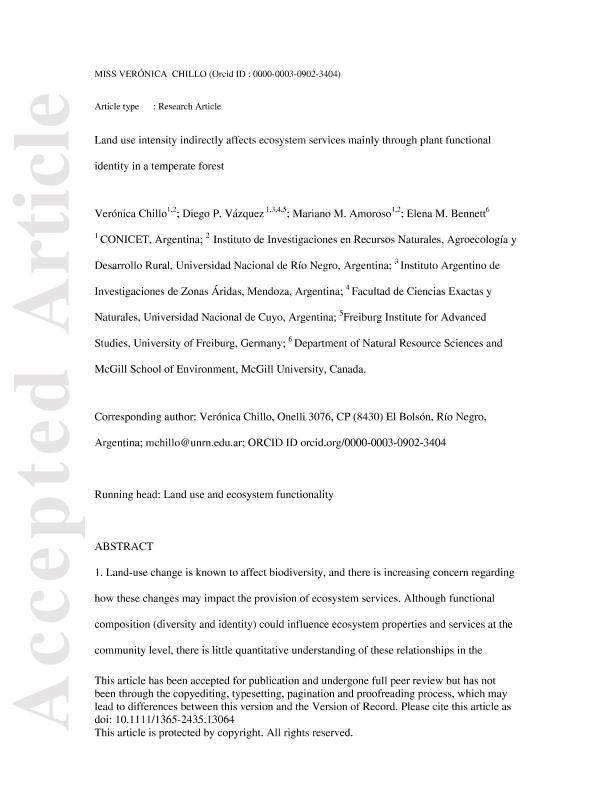Mostrar el registro sencillo del ítem
dc.contributor.author
Chillo, María Verónica

dc.contributor.author
Vazquez, Diego P.

dc.contributor.author
Amoroso, Mariano Martin

dc.contributor.author
Bennett, Elena M.
dc.date.available
2020-04-08T21:11:41Z
dc.date.issued
2018-05
dc.identifier.citation
Chillo, María Verónica; Vazquez, Diego P.; Amoroso, Mariano Martin; Bennett, Elena M.; Land use intensity indirectly affects ecosystem services mainly through plant functional identity in a temperate forest; Wiley Blackwell Publishing, Inc; Functional Ecology; 32; 5; 5-2018; 1390-1399
dc.identifier.issn
0269-8463
dc.identifier.uri
http://hdl.handle.net/11336/102308
dc.description.abstract
Land‐use change is known to affect biodiversity, and there is increasing concern regarding how these changes may impact the provision of ecosystem services. Although functional composition (diversity and identity) could influence ecosystem properties and services at the community level, there is little quantitative understanding of these relationships in the field. Here, we evaluate the direct and indirect effects (through ecosystem properties) of biodiversity on the provision of multiple ecosystem services in native mixed forest in north‐west Patagonia, and how land‐use intensity influences these relationships. We used structural equation modelling to test hypotheses regarding the relationship between understorey plant functional composition, two ecosystem properties, four ecosystem services and silvopastoral use intensity (SUI). We also evaluated two alternative models to assess the mechanism behind biodiversity and ecosystem properties relationships (biomass ratio and niche complementarity). Finally, we performed pairwise correlations to identify synergies and trade‐offs between ecosystem services. SUI affected functional composition, and the provision of three out of four ecosystem services was indirectly affected by land‐use intensity through changes in ecosystem properties. We found that this indirect effect of biodiversity on ecosystem services happens mainly through changes in functional identity rather than functional diversity. Under increasing land‐use intensity, functional composition changed towards a community characterized by a resource acquisition strategy. Trade‐offs between ecosystem services (provisioning vs. regulating) were enhanced under high SUI, while synergies where enhanced under low SUI (provisioning vs. cultural). Thus, although the strength of these relationships varied between SUI, its nature (trade‐off or synergy) stayed the same. Our results expand on previous studies by simultaneously considering the effect of land‐use intensification directly on functional composition and on the ecosystem processes underpinning ecosystem services, as well as on the relationship among them. We provide evidence of an indirect effect of land‐use intensification on multiple ecosystem services through biodiversity. Moreover, we found that functional identity is more important than diversity for ecosystem functionality. Land‐use intensification affects biodiversity, and thus, ecosystem properties, but does not change the relationship among ecosystem services.
dc.format
application/pdf
dc.language.iso
eng
dc.publisher
Wiley Blackwell Publishing, Inc

dc.rights
info:eu-repo/semantics/openAccess
dc.rights.uri
https://creativecommons.org/licenses/by-nc-sa/2.5/ar/
dc.subject
BIODIVERSITY–ECOSYSTEM FUNCTIONING
dc.subject
BIOMASS RATIO HYPOTHESIS
dc.subject
ECOSYSTEM SERVICES TRADE-OFFS
dc.subject
FUNCTIONAL DIVERSITY
dc.subject
FUNCTIONAL TRAITS
dc.subject
LITTER DECOMPOSITION
dc.subject
PATAGONIA
dc.subject
SILVOPASTORAL USE INTENSITY
dc.subject.classification
Ecología

dc.subject.classification
Ciencias Biológicas

dc.subject.classification
CIENCIAS NATURALES Y EXACTAS

dc.title
Land use intensity indirectly affects ecosystem services mainly through plant functional identity in a temperate forest
dc.type
info:eu-repo/semantics/article
dc.type
info:ar-repo/semantics/artículo
dc.type
info:eu-repo/semantics/publishedVersion
dc.date.updated
2019-10-15T17:55:56Z
dc.journal.volume
32
dc.journal.number
5
dc.journal.pagination
1390-1399
dc.journal.pais
Reino Unido

dc.journal.ciudad
Londres
dc.description.fil
Fil: Chillo, María Verónica. Universidad Nacional de Río Negro. Sede Andina. Instituto de Investigaciones en Recursos Naturales, Agroecología y Desarrollo Rural; Argentina. Consejo Nacional de Investigaciones Científicas y Técnicas; Argentina
dc.description.fil
Fil: Vazquez, Diego P.. Albert Ludwigs University Of Freiburg; Alemania. Consejo Nacional de Investigaciones Científicas y Técnicas. Centro Científico Tecnológico Conicet - Mendoza. Instituto Argentino de Investigaciones de las Zonas Áridas. Provincia de Mendoza. Instituto Argentino de Investigaciones de las Zonas Áridas. Universidad Nacional de Cuyo. Instituto Argentino de Investigaciones de las Zonas Áridas; Argentina
dc.description.fil
Fil: Amoroso, Mariano Martin. Consejo Nacional de Investigaciones Científicas y Técnicas; Argentina. Universidad Nacional de Río Negro. Sede Andina. Instituto de Investigaciones en Recursos Naturales, Agroecología y Desarrollo Rural; Argentina
dc.description.fil
Fil: Bennett, Elena M.. McGill University; Canadá
dc.journal.title
Functional Ecology

dc.relation.alternativeid
info:eu-repo/semantics/altIdentifier/doi/http://dx.doi.org/10.1111/1365-2435.13064
dc.relation.alternativeid
info:eu-repo/semantics/altIdentifier/url/https://besjournals.onlinelibrary.wiley.com/doi/abs/10.1111/1365-2435.13064
Archivos asociados
